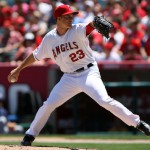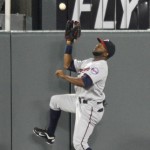 r
rReaders ask creative questions for keeping Morse around. It won't matter. Photo Cheryl Nichols/Nats News Network
Slow week for baseball news; I’m sure that will end tomorrow when the Hall of Fame class (or lack there of) is announced. Meanwhile MLB.com’s Nats beat reporter Bill Ladson published a mailbag on 1/7/13. Here’s how I would have answered his questions.
Update: after I wrote this, LaRoche signed. So much for a slow news week for our Nats. Some of the below may now be slightly dated analysis.
As always, I write the response here before reading his, and edit questions for clarity/conciseness.
Q: If Anthony Rendon stays healthy, could you see Ryan Zimmerman moving to first base and Rendon playing third base?
A: Yes, absolutely. I’m now firmly on the following succession plan: Rendon hits his way to the majors, proves he can play excellent 3B defense, and we move Zimmerman and his nearing-Chuck Knoblock/Steve Sax issues with his throwing arm to first base. Zimmerman would save the wear and tear on his body by not having to field bunts and dive for as many grounders, and would not have to make any more casual throws across the diamond (he’s proven that under duress or when hurried that he is very accurate, a clear indication that when he doesn’t think about the throw, he makes it). And we install Rendon at third where by all accounts he’s just as good a defender as Zimmerman is.
However. There’s a few things that need to happen for this plan to work. Rendon (as the question mentions) needs to stay healthy. He needs to prove he can hit MLB pitching. And the Nats need to NOT lock up first base for the next three seasons with Adam LaRoche, else the position is blocked, Zimmerman stays at 3B for the duration of LaRoche’s deal and Rendon will have to push someone else off their position (Espinosa at 2b is the likely target … but Espinosa is nearly a 4 win player despite his strikeouts. They don’t grow 4 win players on trees). So Rendon may be stuck until another solution presents itself, perhaps by way of injury.
Update: with LaRoche’s signing, we now know that Zimmerman isn’t moving to 1B for at least two years, so now Rendon’s path is more complicated.
Ladson kind of hedges and says “well, lets just see what happens.”
Q: Why the talk of trading Michael Morse when trading Jayson Werth would be far better for the team? Besides all the money it would free up, Morse is three years younger, hits far better, especially with men on base, and has more power.
A: Because who in their right mind would take Jayson Werth with the massively backloaded contract he’s currently on while he’s in his decline years in his mid 30s and has shown himself suddenly to be injury prone?? That sentence is exactly the reason that the Werth contract was and is criticized as being one of the “worst in the game.” Because its unmoveable. He’s going to be paid $21.57 million dollars in the year 2017 when he’s 38. If Werth was still producing at his last Philadelphia year level (he posted a 4.3 bWAR in 2010, which using a rough FA estimate of $5M/war would mean he was “valued” at exactly $21.5M), there wouldn’t be as much complaining. But in the first two years of the contract, he hasn’t produced anywhere near that WAR value (bWARs of 1.0 and 0.6 in the first two years of the contract). Yes he was hurt in 2012, but its not like he’s giving back the money for the 81 games he didn’t play.
This is such an ignorant question, you wonder why Ladson took it.
All that being said, yes I understand why the Nats made the Werth deal. I think it was done fully well knowing what an albatross it was to be. It was done to acquire the competitive nature of Werth and to send a message to the league that the Nationals were a new regime post Jim Bowden.
Ladson talks about Werth’s “non number” contributions to the team, saying he’s more valuable than numbers suggest. I think that’s a really myopic viewpoint of Werth’s contract, his production and the point of the question.
Q: Any worries about losing three left-handers out of the bullpen? That was a big strength last year. What are the options?
A: Was our three lefties really that big of a strenth last year? Other readers here have pointed out Michael Gonzalez‘s complete inability to deal with right-handers (they hit him for a .297/.378/.484 slash line in 2012), meaning that the team really could only trust Gonzalez for solely lefty-lefty matchups. Tom Gorzelanny was the 7th guy out of the pen, the long-man/mop-up guy whose large majority of IP were defined as “low leverage,” implying that despite his excellent ERA in 2012 his production can be replaced relatively easily. Sean Burnett was inarguably great … but also was commanding 3 year guaranteed contracts in a baseball management era where we now know that relievers should be treated as fungible assets and never guaranteed major money to. So allowing him to leave was the right decision to make.
Gorzelanny has been replaced by Zach Duke, who (as I’ll begrudingly admit that “peric the troll” was right about, stemming from a conversation here last September) seems to be a better option and who seems to have been given all of Gorzelanny’s appearances last September (Gorzelanny didn’t appear in a game for nearly two weeks in the middle September).
However, I will admit that I am slightly worried about the fact that we seem set to replace the value of both Gonzalez and Burnett at this point with Bill Bray, who may or may not even make the team. I really thought we’d win the J.P. Howell FA sweepstakes. Now at this point, I’m guessing perhaps the team just trusts the matchups and remembers that Tyler Clippard is lights out against lefties despite being a RHP (lefties hit him for a .170/.260/.259 slash line in 2012, a year when Clippard was significantly worse than in 2011). Maybe the team finds a MLFA or a career reclamation project out there (much as they did with Gonzalez and Duke last year). Or (most likely) maybe the team demands a lefty bullpen arm in trade for the eventual Michael Morse transaction once LaRoche signs on for 2013 and beyond). We’ll see; lots of hot-stove league left.
Ladson thinks there’s more acquisitions coming.
Q: Morse was drafted as a shortstop, so is there a way the Nationals could convert Michael into a second baseman?
A: If Morse’s mobility is that poor in LF, he’d be considered a statute at 2nd. There’s just no way he could possibly move there at this point. Besides, Espinosa is considered a very good defender and the Nats regime values plus defense. He may have been a shortstop once, but that was long ago. Ladson says its never going to happen.
Q: What are the chances the Nats try to make a trade for Giancarlo Stanton? Then they can put Werth or Bryce Harper at first base.
A: Hah. Well, I’m sure the Nats (and most every other team in the league) would kill to have Stanton. But Stanton is probably the most valuable resource in the game; a pre-arbitration premiere slugger. The only thing more valuable probably is a pre-arbitration Ace starter (think Tim Lincecum before he hit arbitration). Stanton is under team control for four more years and isn’t even arbitration eligible yet. On the open market he’s worth $25M/year; he’s set to earn somewhere in the mid $500,000 in 2013. It would have to take something well north of the prospect haul that Tampa Bay got in the James Shields trade, and that trade netted Tampa Wil Myers, basically the best propsect in the game.
The Nats (and most teams in the game) simply do not have enough prospect depth to pry Stanton away. And, the Marlins would have to be crazy to trade him intra-division. Just isn’t happening. I think the penny pinching Marlins keep him for another year and trade him before he hits arbitration, making him someone elses’s escalating salary issue. Ladson says that the team wouldn’t trade for Stanton because their outfield is set for the next two seasons. Really!? You wouldn’t trade away Span or Werth, even if you paid their entire ride, to acquire someone with the talent of Stanton?
Q: What are the Nats’ plans with Jhonatan Solano going forward?
A: Catcher depth. Despite his .300+ BA in his short MLB stint, I don’t think he’s anything more than a 4-A player. We keep him on the 40-man until his options expire and then DFA him, all the while he serves as a 3rd catcher in case Ramos/Suzuki gets hurt. Ladson points out that Suzuki is a FA after 2013, so perhaps Solano becomes the #2 in 2014 and beyond. However, Suzuki has a club option for 2014 that could move this schedule out a year.

